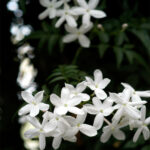Jasmine Flower Plant: A Fragrant Addition to Your Garden
What do you mean by Jasmine Flower Plant?
Jasmine flower plant, scientifically known as Jasminum, is a beautiful and fragrant plant that belongs to the olive family. It is widely popular for its sweet scent and delicate white flowers that bloom in clusters. Jasmine plants are known for their ornamental value and are commonly grown in gardens, parks, and even indoors as houseplants.
How to Grow Jasmine Flower Plant?

Growing jasmine flower plant is relatively easy as long as you provide it with the right conditions. Jasmine plants thrive in well-draining soil that is rich in organic matter. They prefer full sun to partial shade and require regular watering to keep the soil moist, especially during the growing season. Jasmine plants also benefit from regular fertilization to promote healthy growth and abundant flowering.
What is known about Jasmine Flower Plant?
Jasmine flower plants are known for their aromatic flowers that are used in perfumery and aromatherapy. The flowers are often harvested and distilled to extract their essential oils, which are used in the production of perfumes, lotions, and other fragrant products. Jasmine flowers are also used in teas and herbal remedies for their calming and soothing properties.
Solution for Growing Jasmine Flower Plant Successfully
To grow jasmine flower plant successfully, it is important to choose the right variety for your climate and growing conditions. There are many different species and cultivars of jasmine plants, each with its own specific requirements. Before planting jasmine, make sure to research the specific needs of the variety you have chosen and provide it with the appropriate care and maintenance.
Information about Jasmine Flower Plant
Jasmine flower plants are native to tropical and subtropical regions of Eurasia, Africa, and Australasia. They are woody shrubs or vines that can grow up to 15 feet tall, depending on the species. Jasmine plants are prized for their fragrant flowers, which are often used in religious ceremonies, weddings, and other special occasions. In some cultures, jasmine is considered a symbol of purity, love, and prosperity.
Why Choose Jasmine Flower Plant for Your Garden?
There are many reasons to choose jasmine flower plant for your garden. Not only do jasmine plants add beauty and fragrance to your outdoor space, but they also attract pollinators like bees and butterflies. Jasmine flowers are also known to have calming and mood-lifting properties, making them a popular choice for aromatherapy and relaxation. With proper care, jasmine plants can bloom profusely and brighten up your garden with their delicate white flowers.
Tips for Growing Jasmine Flower Plant Indoors
If you want to grow jasmine flower plant indoors, there are a few things to keep in mind. First, make sure to place your jasmine plant in a sunny location where it can receive at least six hours of sunlight per day. You can also supplement natural light with artificial grow lights to ensure your jasmine plant thrives. Water your jasmine plant regularly, making sure the soil is evenly moist but not waterlogged. Prune your jasmine plant as needed to promote bushy growth and remove any dead or damaged branches.
Common Pests and Diseases of Jasmine Flower Plant
Like any other plant, jasmine flower plants are susceptible to pests and diseases that can affect their health and growth. Common pests that may infest jasmine plants include aphids, spider mites, and whiteflies, which can be controlled with insecticidal soap or neem oil. Jasmine plants are also prone to fungal diseases like powdery mildew and root rot, which can be prevented by providing good air circulation and avoiding overwatering. Regular inspection and maintenance can help you identify and address any issues before they become serious.
Conclusion
In conclusion, jasmine flower plant is a beautiful and fragrant addition to any garden. With their delicate white flowers and sweet scent, jasmine plants can brighten up your outdoor space and provide a calming atmosphere. Whether grown outdoors in the garden or indoors as a houseplant, jasmine plants are relatively easy to care for and can reward you with their beauty and fragrance year-round. Consider adding a jasmine flower plant to your collection and enjoy the beauty and aroma it brings to your home.
FAQs (Frequently Asked Questions)
1. How often should I water my jasmine flower plant?
Water your jasmine plant regularly, keeping the soil evenly moist but not waterlogged. Check the soil moisture levels regularly and adjust your watering schedule as needed.
2. Can jasmine flower plant tolerate cold temperatures?
Most jasmine plants are tropical or subtropical in nature and prefer warm temperatures. If you live in a colder climate, consider growing jasmine plant indoors or in a greenhouse to protect it from frost and freezing temperatures.
3. How can I encourage my jasmine plant to bloom more?
To encourage your jasmine plant to bloom more, provide it with ample sunlight, regular watering, and fertilization. Prune your jasmine plant as needed to promote bushy growth and remove any dead or damaged branches.
4. Are there any special care tips for growing jasmine plant indoors?
When growing jasmine plant indoors, make sure to place it in a sunny location where it can receive at least six hours of sunlight per day. Water your jasmine plant regularly and supplement natural light with artificial grow lights if needed.
5. How long do jasmine flowers typically last?
Jasmine flowers are known for their delicate beauty and sweet scent, but they usually last for a few days to a week once they bloom. Enjoy the beauty and fragrance of jasmine flowers while they last, and consider harvesting them for use in teas or perfumes.
